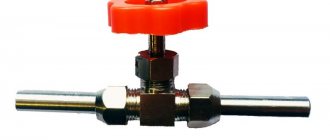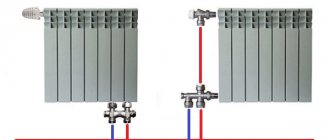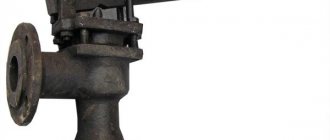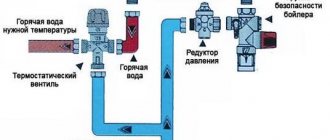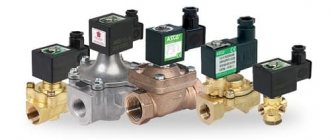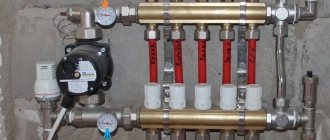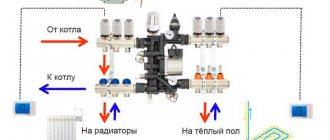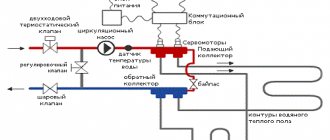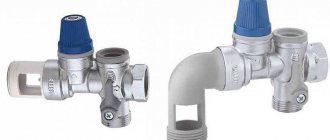Manufacturers
Four-way valves for heating are produced by companies such as Honeywell, ESBE, VALTEC and others.
Today it is a manufacturer that is included in the list of 100 leading global companies compiled by Fortune magazine.
Honeywell 4 way valve
Four-way valves Honeywell V5442A series are manufactured for systems where the coolant is water or liquids with a glycol percentage of up to 50. They are designed to operate at temperatures from 2 to 110 ° C and at operating pressures up to 6 bar.
Honeywell manufactures valves with connection sizes of 20, 25, 32 mm. Therefore, the Kvs coefficient values range from 4 to 16 m³/h. The series devices operate together with electric drives. For systems with higher power, the flanged series of valves ZR-FA is used.
The Honeywell four-way valve will not cause any difficulties during installation; there are many implementation options.
All its products are economical, reliable and convenient to use in heating, cooling and water supply systems.
ESBE offers a 4-way heating valve with internal thread. The valve body is made of brass. Working pressure 10 atmospheres, temperature 110 degrees (short-term - 130 degrees). The four-way mixing valve is produced in sizes 1/2-2″, with a capacity of 2.5 -40 Kvs.
Valtek offers mixing valves for various purposes, which are designed for durable operation in the engineering system (water heated floor, built-in wall, ceiling heating and cooling, hot water supply). The manufacturer's products can be found anywhere in Russia and the CIS countries.
It cannot be said that a four-way valve for heating will not require financial investment. Installing the device will be expensive, however, on the other hand, the operational efficiency and, as a result, profitability, justifies the monetary costs. There is only the main condition - the presence of a high-quality electrical network, since without it the valve drive will stop working.
This allows for somewhat automated control, but does not make it possible to constantly maintain a certain temperature at the inlet to the boiler (which is necessary for the safety and durability of the heat generator). Indeed, with large temperature differences, there is a possibility of condensation forming with subsequent corrosion of the heat exchanger, and the intensity of scale formation also increases. If a cast iron heat exchanger is used, cracks may appear in sections of the heat exchanger. In addition, the stress at the connections of boiler parts increases, primarily at the joints and along the welds.
Therefore, for operational safety and durability of the equipment, as well as to achieve the required level of comfort, four-way valves are used to separate the heating and boiler circuits. In Fig. Figure 2 shows a typical diagram using a solid fuel boiler and a hot water storage tank (one outlet from the boiler, after which the coolant is distributed to hot water heating and the heating system). The separation of the boiler circuit and the heating system circuit is carried out using a 4-way valve, which allows for constant circulation in the boiler circuit and, at the same time, in the heating system circuit.
Rice. 2. Installation diagram of a solid fuel boiler to a heating system with forced circulation of coolant and a 4-way valve: 1 - boiler; 2 — automatic boiler control unit; 3 — coolant temperature sensor; 4 - room thermostat; 5 - circulation pump; 6 – heat consumer; 7 - differential valve; 8 - four-way mixing valve; 9 — expansion tank; 10 - hot water boiler; 11 - boiler pump; 12 — shut-off valves; 13 - filter
At the same time, in addition to the extreme positions, in the middle position 50% of the coolant goes into the heating system, mixing with 50% of the coolant returning from the heating system, and the remaining part returns back to the boiler, mixing with the rest of the coolant from the heating system. It is also possible to maintain, in contrast to regulation with 3-way valves, a flow separation constant in other strictly defined proportions. For example, 30% of the coolant is in the boiler circuit, 70% is in the heating system. Or any other ratio (Fig. 3).
Rice. 3. 4-way valve positions
Such constancy of consumption is very important for a solid fuel boiler, since, as we noted above, when using it there are not such wide opportunities to influence the intensity of the combustion process as in gas boilers. The use of an automatic draft regulator allows you to regulate the temperature only at the outlet of the boiler, but not on the return line
Four-way mixer diagram
H2_2
The principle of operation of such a valve for heating is the rotation of the spindle inside the housing. Moreover, this rotation must be free, since the sleeve does not have a thread. The working part of the spindle has two openings through which the flow opens in two passes. Thus, the flow will be throttled and will not be able to pass directly to the second sample. The flow will be able to turn into any of the nozzles located on the left or right side of it. So, all flows coming from opposite sides are mixed and distributed over four pipes.
There are designs in which a pressure rod works instead of a spindle, but such devices cannot mix flows.
Valve operation is controlled in two ways:
- Manual. Flow distribution requires the rod to be installed in one specific position. This position must be adjusted manually.
- Auto. The spindle rotates as a result of a command received from an external sensor. Thus, the heating system constantly maintains the set temperature.
The four-way mixing valve ensures a stable flow of cold and hot coolant. The principle of its operation does not require the installation of a differential bypass, because the valve itself allows the required amount of water to pass through. The device is used where temperature control is necessary. First of all, this is a radiator heating system with a solid fuel boiler. If in other cases the coolant is regulated using a hydraulic pump and bypass, here the operation of the valve completely replaces these two elements. As a result, the boiler operates in a stable mode, constantly receiving a dosed amount of coolant.
Heating with four-way valve
Installation of a heating system with a four-way valve:
The connection diagram for a heating system with a four-way mixer consists of the following elements:
- Boiler;
- Four-way thermostatic mixer;
- Safety valve;
- Pressure reducing valve;
- Filter;
- Ball valve;
- Pump;
- Heating batteries.
The installed heating system must be flushed with water. This is necessary so that various mechanical particles are removed from it. After this, the operation of the boiler must be checked under a pressure of 2 bar and with the expansion tank turned off.
Please note that a short period of time must pass between the start of full operation of the boiler and its testing under hydraulic pressure. The time limit is due to the fact that if there is no water in the heating system for a long time, it will be susceptible to corrosion.
A four-way valve is an element of the heating system to which four pipes having coolants of different temperatures are connected, and is used to prevent overheating of a solid fuel boiler. The thermostatic valve prevents the temperature inside the boiler from exceeding 110 °C. Already at a temperature of 95 °C it starts cold water to cool the system.
Four way valve design
The body is made of brass, 4 connecting pipes are attached to it. Inside the body there is a sleeve and a spindle, the operation of which has a complex configuration.
The thermostatic mixing valve performs the following functions:
- Mixing water flows of different temperatures. Thanks to mixing, there is a smooth regulation of water heating;
- Boiler protection. The four-way mixer prevents corrosion, thereby extending the life of the equipment.
Four-way mixer diagram
The operating principle of such a heating valve is to rotate the spindle inside the housing. Moreover, this rotation must be free, since the sleeve does not have a thread. The working part of the spindle has two openings through which the flow opens in two passes. Thus, the flow will be throttled and will not be able to pass directly to the second sample. The flow will be able to turn into any of the nozzles located on the left or right side of it. So, all flows coming from opposite sides are mixed and distributed over four pipes.
There are designs in which a pressure rod works instead of a spindle, but such devices cannot mix flows.
Valve operation is controlled in two ways:
- Manual. Flow distribution requires the rod to be installed in one specific position. This position must be adjusted manually.
- Auto. The spindle rotates as a result of a command received from an external sensor. Thus, the heating system constantly maintains the set temperature.
The four-way mixing valve ensures a stable flow of cold and hot coolant. The principle of its operation does not require the installation of a differential bypass, because the valve itself allows the required amount of water to pass through. The device is used where temperature control is necessary. First of all, this is a radiator heating system with a solid fuel boiler. If in other cases the coolant is regulated using a hydraulic pump and bypass, here the operation of the valve completely replaces these two elements. As a result, the boiler operates in a stable mode, constantly receiving a dosed amount of coolant.
Heating with four-way valve
Installation of a heating system with a four-way valve:
The connection diagram for a heating system with a four-way mixer consists of the following elements:
- Boiler;
- Four-way thermostatic mixer;
- Safety valve;
- Pressure reducing valve;
- Filter;
- Ball valve;
- Pump;
- Heating batteries.
The installed heating system must be flushed with water. This is necessary so that various mechanical particles are removed from it. After this, the operation of the boiler must be checked under a pressure of 2 bar and with the expansion tank turned off.
Please note that a short period of time must pass between the start of full operation of the boiler and its testing under hydraulic pressure. The time limit is due to the fact that if there is no water in the heating system for a long time, it will be susceptible to corrosion.
How to make a heating system with a four-way valve
About the operating principle of the valve
Like its more “modest” three-way brother, the four-way valve is made of high-quality brass, but instead of three connecting pipes it has as many as 4. Inside the body, a spindle with a cylindrical working part of a complex configuration rotates on a sealing sleeve.
It has selections in the form of flats on two opposite sides, so that in the middle the working part resembles a damper. It retains a cylindrical shape at the top and bottom to allow compaction.
The spindle with the bushing is pressed to the body with a cover with 4 screws; an adjustment handle is attached to the end of the shaft from the outside or a servo drive is installed. The detailed diagram of a four-way valve shown below will help you visualize what this whole mechanism looks like:
The spindle rotates freely in the sleeve because it has no thread. But at the same time, samples made in the working part can open the flow through two passages in pairs or allow three flows to mix in different proportions. How this happens is shown in the diagram:
For reference. There is another design of a four-way valve, where instead of a rotating spindle, a pressure rod is used. But such elements cannot mix flows, but only redistribute. They have found their application in gas double-circuit boilers, switching the flow of hot water from the heating system to the DHW network.
The peculiarity of our functional element is that the coolant flow supplied to one of its nozzles can never pass to the other outlet in a straight line. The flow will always turn into the right or left pipe, but will never flow into the opposite one. At a certain position of the spindle, the damper allows the coolant to pass immediately to the right and left, mixing with the flow coming from the opposite inlet. This is the principle of operation of a four-way valve in a heating system.
It should be noted that the valve can be controlled in two ways:
manually: the required flow distribution is achieved by installing the rod in a certain position, guided by the scale located opposite the handle. The method is rarely used, since the effective operation of the system requires periodic adjustments; it is impossible to constantly do it manually;
automatically: the valve spindle is rotated by a servo drive that receives commands from external sensors or a controller. This allows you to maintain the specified water temperatures in the system when external conditions change.
Morphological analysis of the word four-way
FOUR WAY
- inanimate
FOUR WAY
- animate
Basic form of the word:
FOUR WAY
All word forms with grammatical information:
| Word | Information |
| FOUR WAY | singular, nominative, masculine, inanimate, animate |
| FOUR WAY | accusative, singular, masculine, inanimate |
| FOUR WAY | singular, feminine, inanimate, animate, genitive |
| FOUR WAY | dative, singular, feminine, inanimate, animate |
| FOUR WAY | singular, feminine, inanimate, animate, instrumental |
| FOUR WAY | singular, feminine, inanimate, animate, prepositional |
| FOUR WAY | singular, masculine, inanimate, animate, genitive |
| FOUR WAY | accusative, singular, masculine, animate |
| FOUR WAY | singular, inanimate, animate, genitive, neuter |
| FOUR WAY | dative, singular, masculine, inanimate, animate |
| FOUR WAY | dative, singular, inanimate, animate, neuter |
| FOUR WAY | singular, masculine, inanimate, animate, instrumental |
| FOUR WAY | singular, inanimate, animate, neuter, instrumental |
| FOUR WAY | dative, plural, inanimate, animate |
| FOUR WAY | singular, masculine, inanimate, animate, prepositional |
| FOUR WAY | singular, inanimate, animate, prepositional, neuter |
| FOUR WAY | singular, feminine, nominative, inanimate, animate |
| FOUR WAY | accusative, singular, feminine, inanimate, animate |
| FOUR WAY | singular, feminine, inanimate, animate, instrumental |
| FOUR WAY | singular, nominative, inanimate, animate, neuter |
| FOUR WAY | accusative, singular, inanimate, animate, neuter |
| FOUR WAY | nominative, plural, inanimate, animate |
| FOUR WAY | accusative, plural, inanimate |
| FOUR WAY | plural, inanimate, animate, genitive |
| FOUR WAY | accusative, plural, animate |
| FOUR WAY | plural, inanimate, animate, prepositional |
| FOUR WAY | plural, inanimate, animate, instrumental |
| FOUR WAYS | inanimate, animate, comparative degree (for adjectives) |
| FOUR MOVES | inanimate, animate, comparative degree (for adjectives) |
| FOUR WAYS MORE | second genitive or second prepositional case, inanimate, animate, comparative degree (for adjectives) |
| FOUR MOVES | second genitive or second prepositional case, inanimate, animate, comparative degree (for adjectives) |
Popular manufacturers
There are many manufacturers of three-way valves on the domestic market. The choice of one model or another depends, first of all, on:
- type of mechanism (and let us remember, it can be mechanical or electrical);
- areas of use (DHW, cold water, “warm floor”, heating).
Esbe is rightfully considered the most popular device.
- a Swedish valve from a company that has been around for over a hundred years. This is a reliable, high-quality and durable product that has proven itself in many areas. A combination of European quality and modern technology.
Another popular model is the American Honeywell - a true brainchild of high technology. Simple operation, convenience and comfort, compactness and reliability - these are the distinctive features of these valves.
Finally, relatively “young” but promising devices are valves from the Valtec line - the result of joint cooperation between engineers from Italy and Russia. All products are of high quality and are sold with a seven-year warranty. They differ in that they have a very affordable price.
Valves classification
Without lengthy introductions, we note that the device can be of two types according to the principle of operation. It could be:
- dividing;
- mixing.
The features of each type of action are clear from their names. The mixing device consists of two outputs and an input. In other words, it is necessary to mix fluid flows, which may be required in order to reduce its temperature. By the way, this is the most optimal option for setting the desired mode in the “warm floor”.
The procedure for adjusting the temperature regime is extremely simple. You just need to know about the current temperature indicators of the incoming liquid flows, accurately calculate the required proportions of each of them so as to obtain the required indicators at the output. By the way, this device, subject to proper installation and adjustment, can also function for flow separation.
But the separating valve divides one flow in two, therefore, it is equipped with one inlet and two outlets. This device is used primarily to separate the flow of hot water in hot water systems. Although quite often it is found in the piping of air heaters.
Externally, both options are almost identical. But if you look at their cross-sectional drawing, their main difference is immediately visible. The rod, which is installed in a mixing-type device, has one ball valve. It is located in the center and blocks the main passage.
As for separating devices, the stem has two such valves, which are installed at the outlets. They function according to the following principle: one of them is pressed against the saddle, closing the passage, and the other, in parallel, opens passage No. 2.
According to the control method, modern models can be:
- electrical;
- manual.
In most cases, a manual device is used, which in appearance resembles an ordinary ball valve, but is equipped with three outlet pipes. But electric models with automatic control are used mainly in private homes, namely to distribute heat. For example, the user can set the temperature regime by room, and the working fluid will flow in accordance with the distance of the room from the heating device. As an option, you can combine it with a “warm floor”.
Video - Device in a boiler group
Three-way valves, as well as other devices, are determined in accordance with the pressure in the system and the diameter of the inlet. All this is regulated by GOST. And if the requirements of the latter are not met, this will be regarded as a gross violation, especially when it comes to the pressure indicator in the line.
Device and functions
The four-way heating valve rotates the spindle in the housing itself. Rotation must be carried out freely, because the bushing does not contain threads. The functioning part of the spindle has a pair of recesses, with the help of which the flow through two passages is opened.
As a consequence, the flow is regulated and is unable to pass directly to the second sample. The flow can turn into any pipe that is located on the left or right side of it. It turns out that all the flows that pass from different directions are mixed and dispersed through four pipes.
There are devices where a pressure rod functions instead of a spindle, but such designs are not intended to mix flows.
A four-way valve for heating is an element of a heating system to which four pipes are connected, having a coolant of different temperatures. Inside the housing there is a sleeve and a spindle. The latter has to work with a difficult configuration.
The operation of a 4-way mixer can be controlled as follows:
- Manual. In this case, to distribute the flows, it is necessary to install the rod in one specific position. And this position must be adjusted manually.
- Automatic (with thermostat). Here, an external sensor gives a command to the spindle, as a result of which the latter begins to rotate. Because of this, the heating system maintains a stable specified temperature.
Installation diagram of a four-way mixing valve in a heating system
The main functions of the 4-way valve are as follows.
- Mixing water flows with different heating temperatures. The device is used to prevent overheating of a solid fuel boiler. The four-way mixing valve does not allow the temperature in the boiler equipment to rise above 110 °C. When heated to 95 °C, the device starts cold water to cool the system.
- Protection of boiler equipment. The 4-way valve prevents the formation of corrosion and thereby extends the service life of the entire system.
Thanks to the 4-way heating valve, a uniform flow of hot and cold coolant is achieved. For normal operation, no bypass installation is required, since the valve itself allows the required volume of liquid to pass through. The device is used where temperature regulation is required. First of all, in the heating system with radiators in conjunction with a solid fuel boiler. If in other cases the fluid is adjusted using a hydraulic pump and bypass, then in this case the operation of the valve completely replaces these devices. It turns out that the boiler functions stably and constantly receives a certain volume of coolant.
Tadiran air conditioner repair. Replacing a four-way valve in a Tadiran air conditioner
Let's consider replacing a four-way valve in a Tadiran air conditioner, as well as the possibility of adapting a used four-way valve from another air conditioner. According to tradition, we install the external air conditioner unit on the stand and check the parameters. If the valve is faulty, the following problems are identified:
The air conditioner does not switch to heating mode,
The air conditioner does not switch to cooling mode,
· the compressor runs, but nothing happens (no heating, no cooling on any of the radiators). In this case, most often there is a strong hissing in the external unit.
In this case, it does not switch to heating mode. We disassemble the external unit and pump out the old freon into a used freon cylinder.
Next, I suggest simply cutting off the tubes going to the four-way valve with side cutters. The old valve has been removed. Next, I propose to figure out why we are installing a used valve and not a new one. The valve has a simple device and it is not difficult or expensive to purchase, but installation will take a lot of time. Inside the valve, the moving element is a rod made of plastic, and the connecting tubes are no more than 5 cm long, so during soldering, the valve must be cooled, otherwise the rod will melt and the valve will fail. In addition, the solder seams are inverted and soldering occurs upside down, and for this it is necessary to unsolder all the tubes and the compressor, i.e. unsolder and solder back the entire air conditioner. I am against unnecessary soldering operations, since this leads to the formation of scale inside the tubes, and scale is washed out only under the conditions of the manufacturer. We try on a used valve with tubes at the installation site, I was lucky - the valve turned out to be complete with a service suction port, we can use it. We are planning three solder seams.
Next, I cut the tubes to size and a suitable pipe from below, pass through with a pipe expander of the appropriate size. Next, we perform soldering with an oxygen torch and solder containing silver. The photo shows the compressor discharge tube. We also bend, expand and solder the suction tube of the compressor.
The inlet pipe of the condenser (radiator of the external unit) is soldered directly into the tee without expansion, and is pre-bent. A very important point - the pipes should not touch each other, as well as the housing and the compressor; to do this, bend them or even fasten them with ties through a rubber shock absorber.
We assemble the housing, connect the stand pipes, vacuum it, fill it with freon and check the operation of the entire external unit. https://www.youtube.com/watch?v=SGmvIKLB9I8
The operating parameters of the external unit in heating and cooling mode are not ideal, but close to it. Let's summarize the work - disassembly, three solder seams and four
How it works
The three-way valve is installed in those sections of the pipelines where it is necessary to divide the flow of circulating fluid into 2 circuits:
- with variable hydraulic mode;
- with constant.
In most cases, a constant flow is required by those who are supplied with liquid of high quality and in designated volumes. It is regulated in accordance with quality indicators. As for the variable flow, it is used for objects where quality indicators are not the main ones. The quantity coefficient is of great importance there. Simply put, the coolant is supplied there according to the required quantity.
Note! Shut-off valves also include an analogue of the device described in the article - a two-way valve. How is it different? The fact is that the three-way option works on a completely different principle
The rod included in its design is unable to block the flow of liquid, which has constant hydraulic parameters.
The rod is open all the time, it is adjusted to a particular volume of liquid. Consequently, users will be able to get the volume they need, both in terms of quantity and quality. In general, this device is unable to stop the flow of fluid to a network in which the hydraulic flow is constant. In this case, it may well block a flow of variable type, due to which, in fact, the possibility of adjusting the flow/pressure arises.
And if you connect a pair of two-way devices, you can get one, but three-way. But it is necessary that both work in reverse, in other words, when one valve closes, the next one must open.
Characteristics of three-way heating valve
A three-way valve for heating is especially necessary when the house needs to distribute hot water evenly in radiators, the water supply system and in the underfloor heating system.
Construction device
Externally, a three-way faucet looks like a triple outlet; such a part is made of bronze or cast from brass; there is a plastic rotating handle on it, with which you can regulate the water supply. Underneath it is a sensor that reacts to heat and a rod in which a cone-shaped element is firmly installed.
The valve design consists of:
- metal case;
- temperature sensing regulator;
- element in the form of a cone;
- stock;
- sitting;
- pressure mixing zone;
- sealing element.
Shut-off valves correct inconsistent water temperatures. Using such a system not only provides comfort, but also allows significant savings. This is due to the fact that due to the regulator there is significantly less fuel consumption for heating. And in a heated floor system, this is also an irreplaceable thing; it does not allow the floors to overheat, creating uncomfortable sensations; it provides smooth, unnoticeable heating.
The principle of operation of the design
The valve is usually installed in the heating system where the flow needs to be divided into 2 circuits. In the first there is a flow with a constant temperature, and in the second, on the contrary, with a variable temperature. Typically, a constant temperature must be maintained where the flow must be at the required volume and quality. It will be monitored based on these indicators.
A flow with a variable temperature can be used where there are no requirements for the quality of the liquid. In this case, attention is paid to the quantitative indicator, that is, the requirements for the volume of water.
Two way control valve
There are two-way valves, two of which can be combined with each other to create a three-way valve. Only such a pair should work in reverse, because when one element closes, the other opens.
Water flows through the hoses until it reaches the set temperature level. The valve ensures that water flows directly into operation from the boiler room at the required temperature, previously set by the regulator.
If the temperature limits are nevertheless violated, the valve component that presses on the stem will operate. The rod will move, and the cone-shaped element will come out of the seat, thereby opening the channels. This process continues until the temperature becomes the same as was initially necessary.
There is a three-way valve for heating with a ball part instead of a cone part. Then the rod will rotate. There is another type of valve, there will be a sector instead of a ball. The sector simply blocks the water flow.
Types of three-way designs by type of drive
The actuator plays an important role in the operation of the valve.
Systems are classified by drive type.
The usual actuator valve system is that the actuator presses on the stem due to a temperature sensor, the norms of which are set in advance. This standard drive can be replaced with any other.
The process is controlled by a temperature-sensitive element using a temperature sensor, which can be removed for replacement. A three-way valve for heating equipped with such a component copes with its task better than others.
Motorized 3-way valve
Electrically actuated valves have become popular in use. The meaning of the work is that a special controller controls the drive. There are regulating electrical components that constantly measure flow data and send a signal to the controller, which in turn regulates the operation of the drive.
The valve with gas thermostat is equipped with a servo drive. This system works without a controller and is regulated by a tap. It receives a warning from the thermostat. Usually it contains a spherical or sector element.
Classification by operating principle
According to the principle of operation, the valve is divided into separating and mixing.
The mixing valve mixes hot and cold streams together. This system is best suited for heated floors. How does temperature control work? You need to know the temperature data of the incoming flows, this will help you calculate the proportions and fulfill the required values.
The separating valve has one inlet and 2 outlets. If the fittings are installed correctly, it will divide the flow into two.
Externally, these devices are no different. But there are differences inside. The heat sensitive mixing valve has a stem with a ball valve. Usually it is in the middle and closes the exit.
The separating system has two valves in the stem. The first valve presses on the seat and closes the channel, while the second one opens another channel.
Operating principle of three-way valve
The mixing system can be manual or electric. The most commonly used method is the manual system. It looks like a faucet, which has a ball-shaped control component and three pipe branches.
The electrical system implies automatic control, usually used in a private house for high-quality heating. And it is also quite possible to combine a heated floor system with the heating process.
Valves with a thermostat must be selected taking into account the pipe diameter and pressure coefficient, otherwise the entire system can be disrupted.
Pros of installing a three-way valve:
Three way valve installation
- easy to install;
- no need to track work;
- easy to operate and easy to change;
- durability of use;
- the breakdown can be repaired yourself;
- the valve is absolutely impenetrable;
- low hydromechanical resistance;
- the water flow does not stagnate.
Installation diagram
The valve is installed for the heating process according to the scheme with the first circuit.
In the first circuit, water passes through, heating to the desired temperature, usually 40–50 degrees Celsius. Then comes the launch of the rod, which opens cold streams of water. For the system to operate efficiently, a pump must be installed after the valve.
An option is possible where the main role is played by the pump and thermostat. After the first circle, the water heat flow will flow as needed and circulate throughout the entire system. The pump and tap will be subordinated to the controller.
Install the fittings so that the pressure gauge arrows point to the movement of water.
If welding is necessary during installation, care must be taken to ensure that the valve does not overheat. And it needs to be installed in an accessible place.
It is possible and even necessary to install a filter to purify water, since some valves are of low quality. It is recommended to choose good filters and change them as needed.
Selection rules
There are several recommendations on how to choose the right valve.
You should pay attention to the size of the temperature controller connectors, because they must fit the system pipes. Typically the diameter is 2–4 cm. If you still don’t have a suitable size, you can use an adapter.
Pipe throughput indicators play a very important role in installation.
If it is decided that the valve will be installed for the operation of underfloor heating, then you need to make sure that the follower drive may be connected.
It is better to consult a specialist about purchasing a thermostatic valve. An installation error can lead to temperature changes in the flows. And the most unpleasant moment can be a pipe burst.
Selection of popular models
The Esbe brand valve is one of the most popular. The production of fittings has been established for decades in Switzerland. Over the period of its existence, the company has established itself as a reliable supplier producing quality products.
Honeywell also produces taps; they are convenient and easy to use. They are relatively small in size and have a long service life.
Although Valtec products have recently appeared on the market, the company has already established itself as a dynamically developing company and has already entered into supply agreements with Russia and Italy. This product comes with a 7-year warranty at a very affordable price.
The IMI Heimeier model is popular - it is a safety valve with a separation-type thermostat. It does an excellent job of distributing hot and cold flows. The part is cast from bronze and equipped with a cap. The stem is made of stainless steel, with a powerful ring-shaped seal.
The model comes with only a flat seal or seal and triple development. If you need to connect with fittings, you usually resort to welding or soldering. The seal can be cone-shaped or external thread. If you need to connect with fittings, then the pipes are suitable from steel, copper or plastic.
conclusions
A three-way valve for heating is used in the water supply system in order to obtain it at the desired temperature. Like a regular faucet that adjusts the water warmer or colder.
When purchasing such fittings, pay attention to technical characteristics, such as diameter, whether it is possible to install a follower drive, and how much volume the water supply can withstand.
Reviews
Stanislav, 42 years old: “I use such a device, I want to share my experience. If you cannot influence the flow temperature in any way, then know that you can influence its quantity. A three-way valve with a thermostat limits the volume of water, so that the room will heat up, regardless of the amount of incoming water. The three-way valve for heating and the thermostat, which is installed on the battery, can be used separately. But in private homes it is better to use a mixed method for efficiency.”
Anatoly, 55 years old: “You can control the temperature in the rooms in another way. If the valve with a thermostat is switched to another operating mode, for example, change the temperature of the water before it reaches the batteries. You can switch on the boiler itself, if in a private house. And in an apartment building, since access to the boiler room is limited, the heat generated can be regulated.”
Video: Three-way valve for heating systems
teplyhouse.ru
How to install a mixing valve yourself
This installation scheme is used mainly in boiler rooms of those heating systems that are connected to a hydraulic separator or to a free-flow collector. And the pump located in circuit No. 2 ensures the required circulation of the working fluid.
Note! If the three-way valve will be connected directly to a bypass heat source connected to port B, then it will be necessary to install a valve with a hydraulic resistance equal to the same resistance of this source
If this is not done, then the flow rate of the working fluid in the segment A-B will fluctuate in accordance with the movement of the rod. We also note that this installation scheme provides for the possible cessation of liquid circulation through the source if the installation was carried out without a circulation pump or a hydraulic separator in the main circuit.
It is not advisable to connect the valve to heating networks or a pressure manifold in the absence of devices that throttle excessive pressure. Otherwise, the fluid flow in section A-B will fluctuate, and significantly.
If overheating of the return is allowed, excessive pressure is eliminated by means of a jumper installed parallel to the valve connection in the circuit.
Schematic illustration
The functionality of a four-way valve is based on the rotation of a spindle installed inside it. Its movement is not limited since there is no thread on the bushing. There are 2 selections on the working part of the moving element. Water flows through them through two channels. This leads to the fact that liquid cannot enter all channels at the same time and is distributed evenly.
Schematic representation of the valve operating mode Source domotopim.ru
Healthy! The moving coolant enters one of two pipes located on the right or left side of it. This principle is used to mix water throughout the entire system.
There are models of four-way valves without a spindle. Instead, a pressure rod is installed. The disadvantage of this design is the lack of a stream mixing function.
The operation of the four-way valve is controlled in 2 ways:
- Manual. To distribute the liquid, the rod is installed strictly in one position. Setting modes is also done manually.
- Automatic. The rotating element begins to move after receiving a command transmitted by a sensor installed outside. The specific design ensures that a constant set temperature is maintained.
A four-way valve for heating is used to reduce the excessive consumption of the coolant used. The simple design of the device allows the element to be operated without differential bypasses, due to the valve’s ability to pass only a certain volume of liquid through itself.
The device is indispensable where constant monitoring of the coolant temperature is necessary. First of all, these include radiator-type heating systems with a boiler powered by solid fuel (wood, coal).
In cases with other heating systems, the temperature of the coolant is regulated thanks to a water pump and bypass; here these functions are assigned to a four-way valve. As a result, the operation of the boiler is stable, and the amount of coolant received does not exceed the norm.
